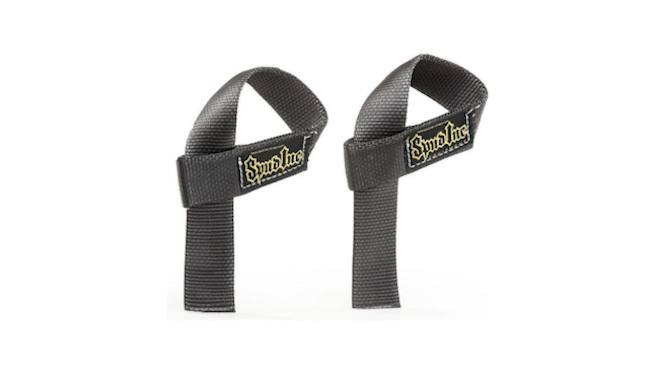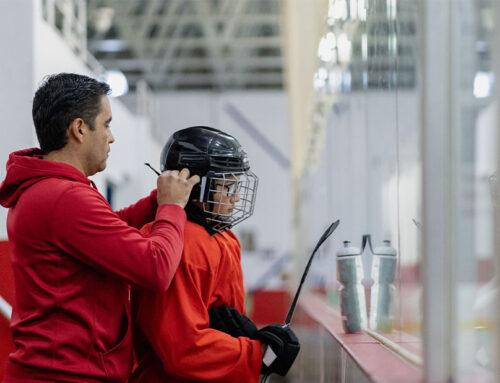Everything You Need to Know About Lifting Straps
Grip strength often becomes a limiting factor with exercises like Hang Power Cleans, Deadlifts and Rows once an athlete becomes fairly strong.
Simply put, their legs and back can handle heavier weights, but due to the barbell or dumbbell slipping out of their hands, they must train with lighter loads. This negatively affects overall strength development.
The solution? Lifting straps.
Just in case you aren’t familiar with lifting straps, they’re an accessory that aids grip. They typically look something like this:

You wear one strap on each hand, putting the loop around your wrist and wrapping the loose end around a barbell, dumbbell, etc. This creates a connection between your hand and the bar that’s stronger than the strength of your fingers. Not only can you hold and move heavier weights this way, it also increases safety. This video offers a good explanation of how to actually use lifting straps properly. The biggest keys with your basic lifting straps are to make sure the loop is positioned around your wrist so the end of the strap extends across your palm in the direction of your thumb, and that you start your wrap around the bar by looping it underneath the bar rather than over top of it.
Unless you’re specifically trying to increase grip strength through targeted grip and forearm work, you never want to be lifting weights that have a high possibility of slipping out of your hands during a set. A slippery barbell or dumbbell may land on your foot or shift your body into an unsafe position, leading to injury.
A few different types of straps exist, but I’ve found your basic loop strap to be the most versatile and useful. Buy a pair of high-quality loop straps, and you’ll reduce your risk of missing lifts due to lacking grip strength. But not everyone is such a big fan of this accessory.
Should You Use Lifting Straps?
Training purists will argue against strap usage. They’ll say it takes away from increasing your grip and forearm strength. Just chalk up and build “real” strength, they say.
Still, you have to ask yourself: “Am I using this exercise primarily to develop my grip?”
If it’s a compound movement like a Hang Power Clean or Deadlift, the answer is no. Depending on the exercise, I’ve found you can often lift up to 20-30% more with straps compared to going barehand.
For instance, let’s say you could Hang Power Clean 225 pounds with straps. But without them, anything above 180 slips out of your hands. That’s 45 pounds you’re leaving on the table!
Also note that smaller athletes, particularly women, have smaller hands, which affects their ability to grip a barbell or dumbbell. No amount of chalk will help you overcome this physical disadvantage.
Internet tough guys carry their calluses and ripped hands like a badge of honor. Mangled palms may come with the territory in powerlifting. But I don’t see how busted hands improve performance on game day for a hockey, basketball or tennis player who must rely on their hands to make plays. With that in mind, let’s talk about which exercises work well with straps, and which do not.
When to Use Lifting Straps
When you perform a pulling movement or posterior chain exercise with maximal or near maximal weights, your grip will often give out before your upper back, traps, lats or hamstrings. To combat this, I highly recommend using lifting straps.
On warm-ups, go barehand for as long as possible. You can use straps on the last one or two warm-up sets before your first work set on exercises like Hang Power Cleans, Deadlifts or Dumbbell Split Squats. But other than that, forgo straps and opt to develop your grip at submaximal loads, instead.
Hang Power Cleans
Performing Power Cleans off the floor allows you to reset your grip between each rep. You can’t do so with Hang Power Cleans, which is the favored Clean variation for many field sports athletes, because you’re gripping the bar for the entire set.
Straps remove this limitation. Furthermore, you can really focus on accelerating the bar without thinking about your grip. So, using straps can increase bar speed, which is a very good thing when trying to develop more powerful athletes. Just be sure to leave a little bit of slack between the strap and bar so that your wrists have enough room to maneuver around it for the catch.
Note that with very heavy weights, holding on to the bar becomes difficult—even when using straps. Thus, you will need to loop the straps tighter around the bar, which does restrict wrist movement in the catch. This can make Hang Power Cleans with straps potentially dangerous. While I have never witnessed an injury, it’s something to keep in mind.
Deadlifts
Many powerlifters Deadlift with a mixed grip (one hand over, one hand under) but it can lead to a biceps tear.
I don’t work with powerlifters, and there’s a good chance you’re not training for a powerlifting meet either, so there’s no reason to risk it. I usually have my athletes switch from a mixed grip to a double overhand grip with straps around the 400-pound mark.
Rows and Pulldowns
Barbell Rows, One-Arm Dumbbell Rows, Seated Cable Rows and Lat Pulldowns are staple exercises for building a bigger and stronger back. To get the most out of these movements, you’ll want to properly engage your lats and rhomboids.
Without straps, your forearms and biceps will take over at heavier weights just to get the dumbbell or weight stack moving. If you can’t feel Rows or Pulldowns in the intended muscles, your back development will suffer.
Single-Leg Exercises With Dumbbells
Stronger athletes will be performing Split Squats, Bulgarian Split Squats and other single-leg dumbbell exercises with well over 200 pounds. Holding 100-plus pounds in each hand while your legs pump away can tire out your grip fast.
Also note that since you’re practically performing one set twice (once on both legs), your grip is blasted with double the volume your legs are. For example, four sets of Dumbbell Reverse Lunges turns into eight sets for the hands and forearms. Thus, your grip can fail long before your legs, so lifting straps are pretty much mandatory when you get to heavy enough weights.
When Not to Use Straps
Straps offer no benefit when you’re pressing something away from your body. Likewise, there’s no advantage to using them on direct arm work, because the loads used won’t exceed what you can hold in your hands. So, our list of exercises where straps are excluded contains:
- Horizontal and Vertical Presses
- Curls
- Triceps Extensions and Pushdowns
Then we also have 50/50 exercises like Chin-Ups and Farmer’s Walks. Whether or not to use straps here comes down to personal preference and your training goals.
Personally, I don’t use straps on Chin-Upss with my athletes. I want them to be able to pull their body weight (and whatever external resistance they’ve attached to a belt) over the bar on their own.
However, I don’t see anything wrong with using straps for Chin-Ups/Pull-Ups in higher rep ranges for bodybuilding style training. Taking out the grip allows you to feel the lats better, which helps create a stronger mind-muscle connection.
Farmer’s Walks are another exercise where you could go either way. While these are traditionally done chalked up, straps can be used to overload your upper traps, core and legs because you’ll be able to move bigger weights over greater distances.
What Are the Best Straps for Lifting?
You know those cheap brown leather straps that Gramps must have left behind the power rack back in the 1970’s, and nobody has touched ever since?
Years ago, I happened to find them at a public gym. Since I had forgotten my quality nylon straps at home, I had to resort to Gramps’ leather straps. Digging into the skin right below my wrists, they felt more like a torture device rather than a lifting aid. And guess what? They broke on my first set of Deadlifts in the low 400’s.
I have yet to find a pair of leather straps that I was happy with. Either they cut into your skin or break when lifting heavy, rendering them useless. Quality leather straps may exist, but I’m not holding my breath.
My absolute favorite lifting strap is the 1.5-inch strap made by Spud. The thick nylon is incredibly strong but comfortable. From a performance standpoint, they may well be the last straps you’ll ever need to buy. I’ve had this pair for four years now, and while there’s some natural wear and tear on them, I have yet to encounter a weight or movement where the Spuds don’t stand up to the task.
READ MORE:
RECOMMENDED FOR YOU
Everything You Need to Know About Lifting Straps
Grip strength often becomes a limiting factor with exercises like Hang Power Cleans, Deadlifts and Rows once an athlete becomes fairly strong.
Simply put, their legs and back can handle heavier weights, but due to the barbell or dumbbell slipping out of their hands, they must train with lighter loads. This negatively affects overall strength development.
The solution? Lifting straps.
Just in case you aren’t familiar with lifting straps, they’re an accessory that aids grip. They typically look something like this:

You wear one strap on each hand, putting the loop around your wrist and wrapping the loose end around a barbell, dumbbell, etc. This creates a connection between your hand and the bar that’s stronger than the strength of your fingers. Not only can you hold and move heavier weights this way, it also increases safety. This video offers a good explanation of how to actually use lifting straps properly. The biggest keys with your basic lifting straps are to make sure the loop is positioned around your wrist so the end of the strap extends across your palm in the direction of your thumb, and that you start your wrap around the bar by looping it underneath the bar rather than over top of it.
Unless you’re specifically trying to increase grip strength through targeted grip and forearm work, you never want to be lifting weights that have a high possibility of slipping out of your hands during a set. A slippery barbell or dumbbell may land on your foot or shift your body into an unsafe position, leading to injury.
A few different types of straps exist, but I’ve found your basic loop strap to be the most versatile and useful. Buy a pair of high-quality loop straps, and you’ll reduce your risk of missing lifts due to lacking grip strength. But not everyone is such a big fan of this accessory.
Should You Use Lifting Straps?
Training purists will argue against strap usage. They’ll say it takes away from increasing your grip and forearm strength. Just chalk up and build “real” strength, they say.
Still, you have to ask yourself: “Am I using this exercise primarily to develop my grip?”
If it’s a compound movement like a Hang Power Clean or Deadlift, the answer is no. Depending on the exercise, I’ve found you can often lift up to 20-30% more with straps compared to going barehand.
For instance, let’s say you could Hang Power Clean 225 pounds with straps. But without them, anything above 180 slips out of your hands. That’s 45 pounds you’re leaving on the table!
Also note that smaller athletes, particularly women, have smaller hands, which affects their ability to grip a barbell or dumbbell. No amount of chalk will help you overcome this physical disadvantage.
Internet tough guys carry their calluses and ripped hands like a badge of honor. Mangled palms may come with the territory in powerlifting. But I don’t see how busted hands improve performance on game day for a hockey, basketball or tennis player who must rely on their hands to make plays. With that in mind, let’s talk about which exercises work well with straps, and which do not.
When to Use Lifting Straps
When you perform a pulling movement or posterior chain exercise with maximal or near maximal weights, your grip will often give out before your upper back, traps, lats or hamstrings. To combat this, I highly recommend using lifting straps.
On warm-ups, go barehand for as long as possible. You can use straps on the last one or two warm-up sets before your first work set on exercises like Hang Power Cleans, Deadlifts or Dumbbell Split Squats. But other than that, forgo straps and opt to develop your grip at submaximal loads, instead.
Hang Power Cleans
Performing Power Cleans off the floor allows you to reset your grip between each rep. You can’t do so with Hang Power Cleans, which is the favored Clean variation for many field sports athletes, because you’re gripping the bar for the entire set.
Straps remove this limitation. Furthermore, you can really focus on accelerating the bar without thinking about your grip. So, using straps can increase bar speed, which is a very good thing when trying to develop more powerful athletes. Just be sure to leave a little bit of slack between the strap and bar so that your wrists have enough room to maneuver around it for the catch.
Note that with very heavy weights, holding on to the bar becomes difficult—even when using straps. Thus, you will need to loop the straps tighter around the bar, which does restrict wrist movement in the catch. This can make Hang Power Cleans with straps potentially dangerous. While I have never witnessed an injury, it’s something to keep in mind.
Deadlifts
Many powerlifters Deadlift with a mixed grip (one hand over, one hand under) but it can lead to a biceps tear.
I don’t work with powerlifters, and there’s a good chance you’re not training for a powerlifting meet either, so there’s no reason to risk it. I usually have my athletes switch from a mixed grip to a double overhand grip with straps around the 400-pound mark.
Rows and Pulldowns
Barbell Rows, One-Arm Dumbbell Rows, Seated Cable Rows and Lat Pulldowns are staple exercises for building a bigger and stronger back. To get the most out of these movements, you’ll want to properly engage your lats and rhomboids.
Without straps, your forearms and biceps will take over at heavier weights just to get the dumbbell or weight stack moving. If you can’t feel Rows or Pulldowns in the intended muscles, your back development will suffer.
Single-Leg Exercises With Dumbbells
Stronger athletes will be performing Split Squats, Bulgarian Split Squats and other single-leg dumbbell exercises with well over 200 pounds. Holding 100-plus pounds in each hand while your legs pump away can tire out your grip fast.
Also note that since you’re practically performing one set twice (once on both legs), your grip is blasted with double the volume your legs are. For example, four sets of Dumbbell Reverse Lunges turns into eight sets for the hands and forearms. Thus, your grip can fail long before your legs, so lifting straps are pretty much mandatory when you get to heavy enough weights.
When Not to Use Straps
Straps offer no benefit when you’re pressing something away from your body. Likewise, there’s no advantage to using them on direct arm work, because the loads used won’t exceed what you can hold in your hands. So, our list of exercises where straps are excluded contains:
- Horizontal and Vertical Presses
- Curls
- Triceps Extensions and Pushdowns
Then we also have 50/50 exercises like Chin-Ups and Farmer’s Walks. Whether or not to use straps here comes down to personal preference and your training goals.
Personally, I don’t use straps on Chin-Upss with my athletes. I want them to be able to pull their body weight (and whatever external resistance they’ve attached to a belt) over the bar on their own.
However, I don’t see anything wrong with using straps for Chin-Ups/Pull-Ups in higher rep ranges for bodybuilding style training. Taking out the grip allows you to feel the lats better, which helps create a stronger mind-muscle connection.
Farmer’s Walks are another exercise where you could go either way. While these are traditionally done chalked up, straps can be used to overload your upper traps, core and legs because you’ll be able to move bigger weights over greater distances.
What Are the Best Straps for Lifting?
You know those cheap brown leather straps that Gramps must have left behind the power rack back in the 1970’s, and nobody has touched ever since?
Years ago, I happened to find them at a public gym. Since I had forgotten my quality nylon straps at home, I had to resort to Gramps’ leather straps. Digging into the skin right below my wrists, they felt more like a torture device rather than a lifting aid. And guess what? They broke on my first set of Deadlifts in the low 400’s.
I have yet to find a pair of leather straps that I was happy with. Either they cut into your skin or break when lifting heavy, rendering them useless. Quality leather straps may exist, but I’m not holding my breath.
My absolute favorite lifting strap is the 1.5-inch strap made by Spud. The thick nylon is incredibly strong but comfortable. From a performance standpoint, they may well be the last straps you’ll ever need to buy. I’ve had this pair for four years now, and while there’s some natural wear and tear on them, I have yet to encounter a weight or movement where the Spuds don’t stand up to the task.
READ MORE:










